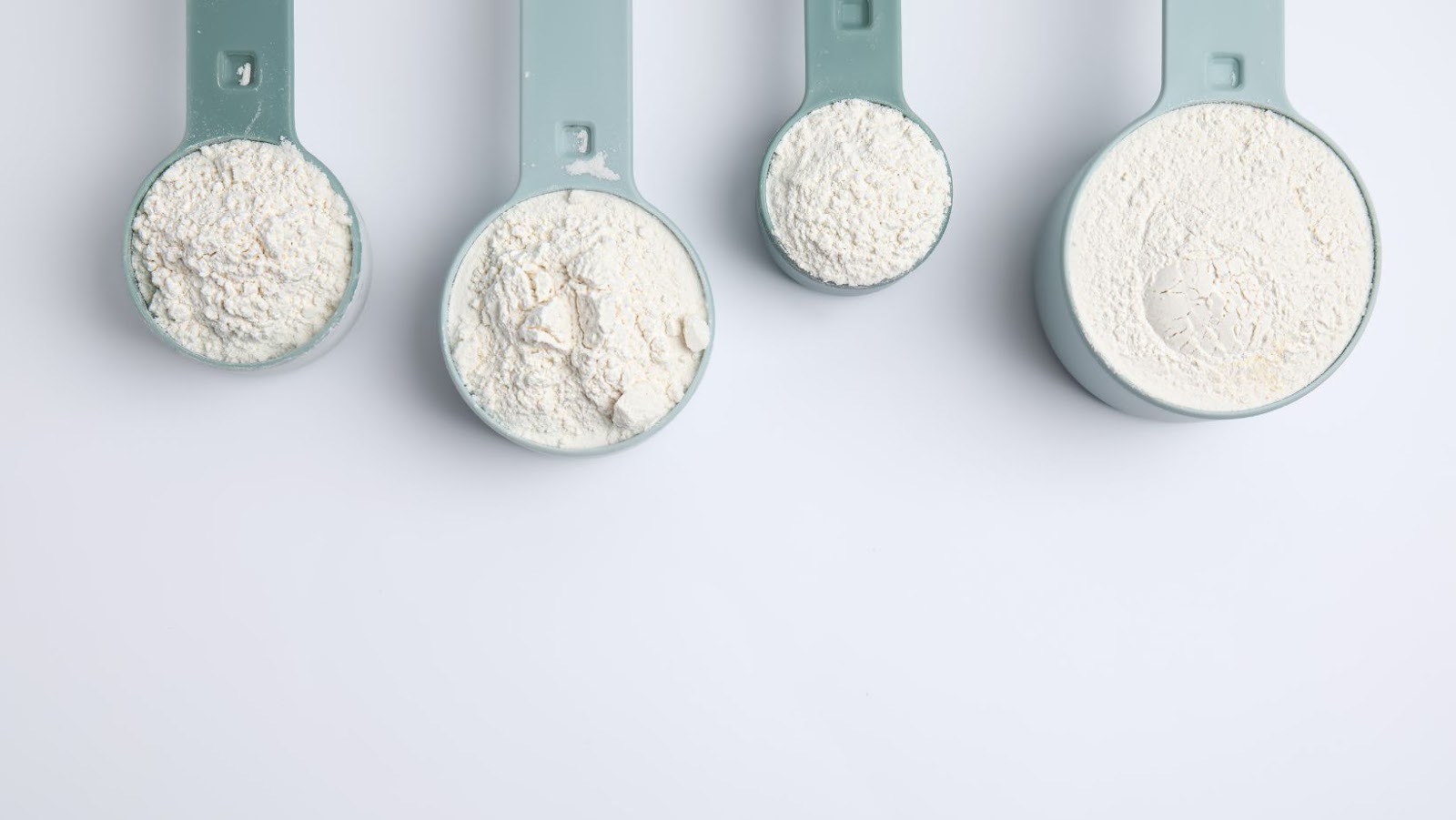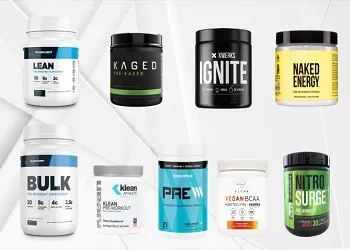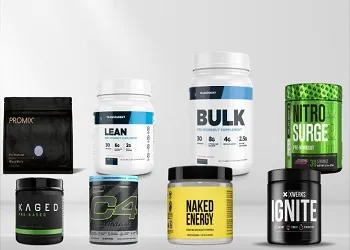If you’re new to supplements, all of the information online about creatine may seem overwhelming, especially when you add the phrase “creatine loading” to the mix.
This leads us to ask a few questions. What actually is a creatine loading phase? Should you even take creatine? Should you do a loading phase or not? Will I build more mass on a creatine loading phase?
Not to worry. It’s not as complicated as it may seem; there is a load of scientific research available on the topic, so experts have done most of the hard work for you.
Let’s break it all down.
Table of Contents
Creatine Overview
Creatine is a naturally-occurring substance found in the muscle cells and in some food sources, but some people choose to supplement with creatine to enhance athletic performance by increasing energy production, muscle function, muscle strength, and muscle mass. Creatine may be supplemented in many forms like from protein powder, pre-workout, or even creatine gummies.
Creatine fulfills the need for a constant supply of energy to the muscles. When your muscles are fully saturated with creatine, it’s going to increase the amount of time before you become fatigued, likely leading you to perform longer and gain strength faster. The creatine loading phase is a scientifically-proven way to increase creatine stores in the muscle faster.
Most anyone interested in increasing their fitness capabilities can benefit from taking creatine monohydrate with or without a loading phase, including bodybuilders, endurance athletes, and strength-based athletes.
Key Points
- The body naturally produces creatine, but not a lot, then it’s (phosphocreatine) converted into adenosine triphosphate (ATP) which the muscles use for energy.
- Lots of evidence exists indicating that creatine supplementation is safe and beneficial.
- Creatine supplementation may enhance strength, increase muscle building, aid in muscle recovery, and generally improve exercise performance.
- Some users choose to do a creatine loading phase, while some do not.
Creatine Loading
The theory behind a creatine loading phase is that by quickly saturating the muscles with creatine, athletes can experience a more rapid increase in muscle mass, strength, and power. A typical creatine loading phase is taking 20–25 grams of creatine for 5–7 days.
After that, users can take a daily maintenance dose of 3–5 grams of creatine. The general consensus in the literature is that the loading phase is not necessary to reap the long-term benefits of creatine supplementation. However, there are some instances where some people may want to load creatine, like if your baseline levels are really low or if you’re in a hurry to maximize your muscle creatine stores. It really comes down to your timeline.
Intramuscular creatine stores (ICS) is the measurement taken to determine how saturated the muscles are with creatine. For people with a “normal” diet (not vegan/vegetarian) muscles are about 60–80% saturated with creatine naturally. Therefore, supplementation can increase ICS by 20–40%. Some evidence suggests that creatine may provide larger benefits to vegans and vegetarians since people who eat less meat are more likely to have lower baseline creatine levels.
Research suggests that if someone loads with creatine, they will saturate their muscle stores after 5–7 days. If someone doesn’t load and just take a maintenance dose from the start, muscle stores of creatine will be saturated after 21–28 days.
After supplement cessation, it typically takes 4–6 weeks for ICS to return to baseline. That is why regardless of a loading phase, a maintenance dose is recommended for users who want to continue to reap the benefits of creatine.
Key Points
- A typical creatine dosage recommendation with a loading phase is taking 20–25 grams of creatine for 5–7 days, which is followed by daily maintenance doses of 3–5 grams.
- Loading creatine provides no significant additional benefits to a maintenance dose, other than speeding up muscle saturation by around 3 weeks.
- Once someone’s muscle cells are fully saturated with creatine, it takes around 4–6 weeks for muscle stores to return to baseline once they stop taking creatine.
How to Load With Creatine
To properly load with creatine, it’s important to follow a specified protocol. Luckily, the International Society of Sports Nutrition (ISSN) produces guidelines regarding creatine supplementation based on the available scientific literature.
As mentioned above, the loading phase typically involves consuming 20–25 grams of creatine per day for 5–7 days followed by daily maintenance doses of 3–5 grams. An alternatively more precise creatine loading dose is to take 0.3 grams of creatine per kilogram of body weight per day. For example, a 180 pound man (82 kg) would take ~25 grams (0.3 x 82) of creatine per day for 5–7 days to complete a loading phase. This is still followed by a maintenance phase of 3–5 grams per day.
It is recommended to divide the loading dose into 4–5 equal doses throughout the day, each containing 4–5 grams of creatine. This ensures the muscles are continuously supplied with creatine and lowers the likelihood of experiencing any gastrointestinal issues.
It is important to stay hydrated during the loading phase. Creatine can cause water retention in the muscles, increasing the chances of dehydration.
Calculate Your Recommended Creatine Intake
Find your appropriate dosage of creatine.
Enter Weight*
Your recommended creatine intake for*
How much steak would you need to eat in a day to load with creatine?
Cooked Beef creatine content: 2 g creatine per 1 lb of cooked steak
The World Cancer Research Foundation recommends no more than 500 g (18 oz) of cooked red meat per week!
Additionally, this study tested the absorption of creatine when it’s administered as meat, a solution, or in solid form, and the solution resulted in the greatest bioavailability. This means that the creatine from a supplement is actually more available to your muscles than creatine from meat.
In most cases, we can get all we need from eating the right foods rather than turning to supplements. Creatine is an exception. You can be perfectly healthy without fully saturating your muscles with creatine. However, if you are an athlete or serious gym goer, you may want to max out these creatine stores with a supplement.
What if I Miss a Dose?
If you’re in the maintenance phase after loading, your muscles should already be saturated with creatine, and this won’t decrease with a missed dose here and there. So if you miss one day for example, there’s no need to compensate for it the following day and take two doses.
If you miss a dose during the initial loading phase, you may want to compensate to stay on track. Personally, I would add a day to your loading phase rather than take higher doses. Anything more than 25 grams in a day is more likely to produce unwanted side effects.
Does Creatine Loading Work?
Yes, creatine loading increases muscle creatine levels faster. In the long term, however, there appears to be no significant difference in creatine efficacy between people that do a loading phase and those that just take a maintenance dose from the start.
Is the Loading Phase for Creatine Necessary?
No, but it will accelerate the process of saturating the muscle and experiencing the benefits of creatine, so it really comes down to your timeline.
So, the answer to the question, “is a creatine loading phase necessary” is no. You will reap the benefits of creatine supplementation if you take it as directed alongside a workout plan with or without a loading phase.
Side Effects of Creatine Loading
Many of you may be wondering, “is loading creatine safe?” As a dietary supplement, creatine has been extensively studied, and based on this research, supplementing with creatine is considered both safe and effective.
Some potential side effects of creatine loading may occur, but they are typically minimal. The most common side effect is weight gain, but this is thought to be due to water retention, since creatine draws water into your muscles. This creates a bit of visible hypertrophy and a small increase in weight. On a related note, you may find yourself more thirsty during a creatine loading phase since the water is going to your muscles.
There is debate over whether those with kidney function impairment should or shouldn’t take creatine. If you have impaired kidney function, or any other existing health condition for that matter, it’s always best to consult your doctor prior to starting a new supplement.
Some studies reported gastrointestinal and digestive issues in users from creatine loading, but this is usually only an issue at very high doses (>10 mg). If you are someone that generally struggles with digestive issues or has a sensitive stomach, creatine loading may affect you more than someone who does not.
Long-Term Use
No long term side effects have been observed. And according to the ISSN, no evidence shows that creatine levels fall below baseline once discontinuing supplementation.
There are a few misconceptions about creatine. For example, the idea that you must take it before a workout, or that it causes hair loss, bloating, or weight gain. There is actually no substantive evidence that indicates it is more effective taken before or after a workout. There is also little evidence base for the other side effects mentioned. However, if you start taking creatine and experience side effects, definitely speak to a qualified professional about the matter.
Key Points
- A loading phase will saturate your muscles with creatine faster (after 5–7 days), but taking a daily maintenance dose will provide the same saturation point and benefits (after 21–28 days).
- Some common side effects that may occur with creatine loading are a slight weight gain and increased thirst. Some people may experience gastrointestinal discomfort, but this is rare.
- No long-term negative effects of creatine loading or supplement use have been identified.
- People with impaired kidney function should discuss creatine supplementation with their doctor.
Research on Creatine Loading
Research on creatine is extensive. This 2021 article titled “Common Questions and Misconceptions About Creatine Supplementation: What Does the Scientific Evidence Really Show” cited that there are over 500 peer-reviewed papers involving creatine supplementation. However, people still wonder if the creatine loading phase is beneficial, or how beneficial is creatine loading to athletic performance.
I reviewed the current research on creatine loading and strength specifically. I wanted to know, does a creatine loading phase enhance training outcomes compared to a non-loading phase?
I was a little surprised to find that no recent studies existed directly comparing a loading phase to not using one. However, research in the 1990s that identified how creatine muscle content increased with a loading phase seems to be a solid foundation for supplementation guidelines today. This 1996 study by Hultman et al. compared ICS in healthy trained males that used a loading phase compared to a group that just took a maintenance dose, and ICS increased by 20% in both groups at the end of the study.
My Experience with Creatine Loading
While anecdotal evidence isn’t usually a good basis for making decisions about your health, it can still be helpful to hear other peoples’ experiences with a supplement.
My husband and I are both looking to increase muscle mass and strength with creatine supplementation alongside resistance training. We did 4 weeks of creatine supplementation (Optimum Nutrition creatine monohydrate). The only difference is that he did a loading phase (20 g for 5 days) and I did not.
Our Experience
As you can see above, I liked mixing my creatine powder into a tasty post-workout shake. I also enjoyed mixing it with coconut water or just plain water. I found that a daily maintenance dose was quite easy to fit into my daily routine. I will say though, it was harder to remember to take on off days from the gym or on weekends when I was out of my normal routine.
I can’t say we have the equipment or the know-how to accurately measure if we improved our strength or performance. I can say that I “felt” stronger in the gym and I wasn’t nearly as sore as I have been in the past when starting back with a regular gym routine. There is no real way of knowing if this was from the creatine or just me getting stronger. However, this is what we have sophisticated sports science research for. 😉
Side Effects
Anthony noticed considerable side effects when loading with creatine over the 5 days.
He said it was difficult to get through a work day having to keep up with the doses, drinking enough water, and going to the bathroom. I noticed an increased thirst as well, but not nearly as much as him. Additionally, Anthony did gain roughly 4 pounds after his 5-day loading period, whereas I didn’t notice any change in weight. Neither of us felt any gastrointestinal issues or bloating from taking creatine.
Final Thoughts
In my opinion, there is no need to load creatine when wanting to increase muscle mass and strength if you can eventually get the same benefits without loading — you’ll just have to wait an extra three weeks approximately. Many people may have no problem with it; I would just much rather take it in lower doses.
All in all, a creatine supplement is a good idea if you are really looking to maximize your performance in the gym. It may even be beneficial for cognitive health, and it may be more beneficial if you follow a vegan or vegetarian diet.
As always, consider consulting a professional to help you maximize your time spent in the gym, lose weight, gain muscle, or feel healthier and stronger. With EverFlex personal training or nutrition counseling, you’ll have a guide to help you achieve whatever your personal fitness goals may be.
Frequently Asked Questions
Can I take 20 g of creatine at once?
It’s not recommended to take more than 3–5 grams at one time. During a loading phase, it’s recommended to take 20–25 grams of creatine daily, but this should be divided into 4–5 doses throughout the day for the best results.
Is a creatine loading phase necessary?
No, a creatine phase is not necessary to experience the benefits from creatine. However, a loading phase will speed up the muscle saturation process by roughly 21 days. In turn, you will reap the benefits that much sooner.
Can I take 10 g of creatine at once?
It’s not recommended to take more than 3–5 grams of creatine at once. Taking more than this may result in side effects like stomach upset and bloating.
How much creatine should a 250-pound man take?
For a loading phase, a 250-pound man should take 34 grams of creatine per day for 5–7 days.
Can I take 10 g of creatine a day in the loading phase?
A daily dose of 10 grams of creatine is not sufficient for a loading phase for the majority of people. If you choose this dosage, it will take longer than 5–7 days to complete a loading phase.
Is 15 g of creatine enough to load?
This depends on your weight. For example, if you weigh 110 pounds (50 kilograms), then your loading phase would be 15 grams per day.
How much creatine is safe for kidneys?
When taken at the appropriate dosages, the latest research indicates that creatine supplementation is safe, even for those with kidney impairment. However, if you have kidney impairment, it is still advised to check with your doctor prior to taking any supplement.
What not to do while taking creatine?
It’s not recommended to take creatine with caffeine as it may lower creatine’s efficacy, but more research is needed. It’s also probably best to avoid alcohol while loading creatine because theoretically, the dehydration that can be associated with creatine may be compounded with alcohol.
Does creatine affect sleep?
There is a limited amount of research that has made the connection between creatine and sleep.
Is 5 g creatine too much?
Five grams of creatine is a “normal” maintenance dose to consume daily and it’s the dose typically provided in creatine supplements. However, if you are a person that weighs 120 pounds or less, 3 grams per day may be better suited to you.
Should I workout during the creatine loading phase?
Yes! In order to fully take advantage of the muscle and strength building benefits of creatine, it’s best to do a loading phase alongside resistance training. For building strength, it’s recommended to do strength training 3–5 times per week.
References













